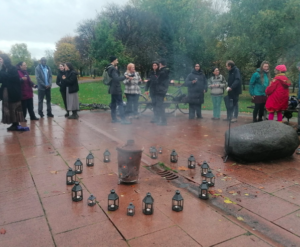Campaigners are no strangers to loss.
Whether they are fighting for livelihoods, justice, or the survival of the planet, the fight is often thankless, disappointing and exhausting – particularly for those who are directly impacted when campaigns fail.
Burnout is a huge risk for changemakers on the front line, so when the losses pile up, how do they keep going? How do they heal whilst doing the work?
We’ve found inspiration from community organiser, Tess Humble, and the activists, campaigners and storytellers she worked with to host Glasgow’s Lament – a ritual designed to bring communities most impacted by economic, social and climate crises together in grief.
In 2021, Glasgow was the host city of COP26 and became the epicentre for climate resistance, campaign and protest. Tess was the Mobilisation Officer for the COP26 Coalition and oversaw the main demo in the city which included 100,000 people and civil society organisations marching to demand climate justice.
”We wanted to match the machine that is COP so we thought ‘the bigger the better’ and tried to get as many people out on the streets as possible but in the end this resulted in burnout,” said Tess. “Afterwards, people felt trodden on and forgotten.”
A year later, and people in the city who had engaged in the COP – particularly the most marginalised – were still coming to terms with the disappointment and burnout. At the same time, the city was facing new crises and threats as the cost of living crisis came into force.
“Following broken climate promises and escalating climate impacts, it felt like we achieved nothing,” said Tess. “We were seeing this increased loss but how do we tend to this loss within our movements while we are still in a time of crises?”
“We live in an era of loss, from climate breakdown, to community, to material security and yet we have lost our traditional mechanisms of grief, such as keening in Scotland and Ireland.”
As the COP26 anniversary approached, she had the idea of hosting a vigil, similar to one in New York which was held for the victims of Covid.
“My goal was for deeper connection, vulnerability and to build relationships within the community,” she said. “We need to build tenderness into movements, particularly those that can be quite masculine in their approach.”
“Tenderness in our work doesn’t take away from powerful strategic campaigns but simply allows space for holding our collective emotional needs too.”
What they did
Tess began by reaching out to food banks and migrant support organisations.
“I didn’t go to the climate movement first. There’s a lot of climate anxiety there, but generally they’re not the people who have experienced the most pain,” she said.
“Many food bank volunteers and migrants understood the need for the lament. If you’re working with malnourished kids and their parents, you close the door at the end of the day and shed tears on your own. They got the spiritual aspect of doing this together, as a way of having your struggles heard.”
She also reached out to local wisdom holders – community elders, storytellers and creatives – to talk about how they could keep the event an emotionally safe place for people, and to agree what could – and could not – be held by the group who gathered on the day.
When sharing news of the event they paid careful attention to the language they used to ensure they didn’t alienate people or sound too abstract.
“We acknowledged the difficulties of rising food insecurity, families who couldn’t afford to heat their homes, exhausted community workers, and we simply asked people to come and tell their stories around the fire,” Tess said.
What happened
And come to tell their stories they did. In the early afternoon on a very rainy day in October, thirty five people gathered in Glasgow Green on the banks of the River Clyde.
There’s a tradition in the city of lamenting those who have died from drug deaths by throwing roses into the river, so the starting point was a symbolic gesture, as Tess said, “we came to throw roses on the broken promises.”
Community worker and storyteller, Lindsey McGhie, led them in procession across the bridge, telling her story of growing up in Govan – a marginalised community in the city – as they walked. She talked about the predicted rising of the Clyde due to climate change, which will see Govan underwater in the coming years.
Once across the bridge, the group gathered in a circle at Nelson’s monument holding onto lanterns with candles. Another local storyteller and activist for migrant rights, Tawona Sithole, originally from Zimbabwe, played music and shared his own stories while inviting other people to share theirs.
“To open people up to be an active part of the group, we simply asked them to say their name and what they grieve in one word or sentence to the beat of a drum,” said Tess.
“Then we went into witnessing our struggles and pains. There were stories of migrant injustice, dictatorships in Sudan, of the huge inequalities within Glasgow and the suicide of young men here. Some people spoke at length, with anger shaking in their voices, some simply said a word or two.”
Tess continued: “We invited everyone to write on a piece of paper what their struggles were and we burned them in front of each other. It was quite spontaneous and a bit chaotic but also beautiful and cathartic. It felt really alive.”
“When you grieve alone there is no container. When you cry with a group there’s something in the collective psyche that knows that you are caught and held and when it’s time to stop.”
It was important to Tess and her fellow organisers that people weren’t left to sit in grief and that they built in a transition towards something more hopeful, or if people didn’t feel hope, then towards an action, a ‘what next’.
“One of the migrant justice groups gave everyone the gift of seeds so we could give something back to the world,” Tess said. “We also wrote messages of hope and resilience on ribbons and tied them to railings.”
“Once all these containers for the grief were in place, it was ok to be joyful. Joyful, standing in solidarity and chaotic with intermittent torrential rain.”
The group walked back to a community centre to talk and break bread together, even picking up a few new faces along the way.
“The Maryhill Integration Network Choir sang songs from around the world,” said Tess. “Everyone fully relaxed into the group because people were so deeply connected. There was space for laughter. Joy did the solidifying.”
What you can do
Tess has shared her advice on how to build a collective grief ritual for your community:
Create a small planning team. “You just need a few people who really get it. Lean on people known in the community, especially people who know how to hold space well, people who are trusted and who can invite stories in.”
Get the right people involved from the start. “In order to do this work it has to centre on the most impacted – I did feel the need to be territorial about this. It’s not enough just to invite them, they have to be around the table from the beginning, shaping the vision and logistics.”
Be graceful in your clumsiness. “Recognise that it is exploratory and a reimagining of what things might look like. We’ve lost a lot of old wisdom, but there’s also a lot we can draw on. Let go of perfection. Be willing to collectively birth something imperfect and beautiful together.”
Consider your language. “This is where bridging comes in. We didn’t want to overtly push a political narrative. This is about building relationships and from here we can create powerful grassroots collectives with a common fight.”
Make it safe. “We made it clear to people in advance about what we can and cannot hold and that the group is a container, not therapy. This asked people to take personal responsibility in the space and respect the limits of the group container.”
Have experienced people on hand. “Lindsey, our storyteller, also has training in counselling and grief. We also worked hard to have someone with experience of holding grief available, such as a humanist, to offer extra support for anyone who needed it (though the humanist we had in mind wasn’t able to make it last minute).”
Keep it small. “It’s better to have about 30 to 40 people maximum, anything larger and it feels less intimate and people are less likely to participate. Even six people can be a really beautiful starting place. Light a candle, read some poems, meet at the river.”
Keep it simple. “Ceremonies don’t have to be complicated to make magic happen. All you need is a framework and for people to share in the vision, everything else comes naturally.”
If you want to find out more, you might find the resources below helpful.
Resources
You can watch a short film of the Glasgow Lament: Naming Our Losses event here.
Tess has written an article – Climate justice, community grief and power building – for Bella Caledonia. She also recommends the book Lost Rites: Community of Grief by Alexandra Grace Derwen.
You can also read This Too Shall Pass: mourning collective loss in the time of Covid 19, a report published by The Collective Psychology Project (Larger Us’ predecessor organisation).


